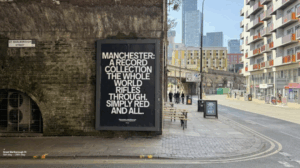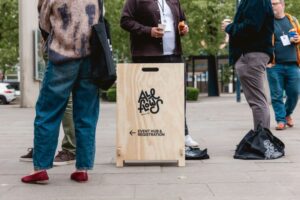A Vision of Design That Transcends Empire’s Grid


Western design has long obeyed the dicta of fin de siècle and early 20th-century Berlin and Paris — that ornament is crime, that form follows function, that clarity trumps complexity. Non-European traditions, however, weren’t peripheral influences to design, but rather systems with their own complex codes. Slipping past the now-famous glass-enclosed forest at the Ford Foundation, I felt the water rippling toward something percussive, living, and deeply modern in Reverberations: Lineages in Design History. The exhibition traces design’s pulse across Indigenous, Black, and other historically marginalized cultures — not as isolated oases, but as multiple continuous and resounding centers.
One form of the show’s refusal of Western design hegemony is its decentering of anthropocentric perspectives. Two Tlingit formline raven masks draw the viewer’s gaze — one wood, one digital; one made by father, the other son. This powerful dyad grounds creation narratives in Indigenous cosmology: Nathan P. Jackson’s “Raven Mask” embodies the bringer of light, while Jackson Polys reinterprets it in “yélaa (verbal noun) (1) imitation; counterfeit | ‘the one that ravens’” (2025), a 3-D rendered mask rotating slowly, shimmering with pixelated iridescence, it edges constantly liquified and reconstituted, an entity in flux.
This grounding in non-Western cosmologies extends to examining tradition through contemporary lenses. Melissa Cody’s electrifyingly bright tapestry gestures to standardized Navajo geometric abstractions, disrupted by digital-like glitches: The deep purple ground of a pixelated argyle panel, for instance, erupts into stark blacks, grays, and whites. This jarring yet beautiful collision of ancestral code and technological interference finds a parallel in Sarah Sockbeson’s “Glowing Sunset on the Carabassett” (2011), a sweetgrass basket whose seamless weave achieves a delicate, waterproof functionality rivaling modern design.

Across oceans and archives, these artists engage alternative knowledge-keeping, historical mapping, and counter-surveillance, dislocating design from the industrial systems of technology and power that have long interpellated it. A late 19th-century “Lukasa Memory Board” made by the Luba people, for instance, encodes grooves and beaded constellations using techniques that once mapped local geographies and genealogies more than a century before Starlink hovered overhead. In a similarly situated approach, William Villalongo and Shraddha Ramani’s map, “Black Migration ½” (2025), draws from one of W.E.B. Du Bois’s lesser-known sociological hobbies — pioneering data visualization — tracing the slave trade across a disarticulated map. Within it, Europe is decentered, rescaled, splayed open like a paper fortune teller — a cartographic design unmoored from empire’s grid.
These acts of reclaiming non-Western knowledge inform Jeffrey Gibson’s assertion of Indigenous sovereignty. Gibson’s pyramid sculpture “Because Once You Enter My House, It Becomes Our House” (2020) engages the idea of simultaneous time, with slogans like “In Numbers Numbers Numbers / Too Too Too / Big To Ignore” and “The Future Is Present” emblazoned on its facades. He counters stereotypes of Indigenous people as incapable of intricate industrial feats of design in honoring the Mississippian metropolis of Cahokia, whose more than 120 earthen mounds at a massive scale, including the colossal Monks Mound, represent an unprecedented feat of prehistoric engineering and organized labor.
I left Reverberations not with the sense of discovery, but of recognition — of seeing with force and clarity what had long been obscured by the bright glare of European modernism. From the dense geometries of Navajo weaving to the code-switched semiotics of Gibson’s sculpture, the show dismantles the myth of a singular design lineage and replaces it with something both more accurate and more arresting: A world in which design has always been plural, relational, and situated. If modernism once flattened difference in the name of universality, Reverberations redraws the map entirely — a map where center and edge are no longer fixed, but continuously in motion.



Reverberations: Lineages in Design History continues at the Ford Foundation Gallery (320 East 43rd Street, Murray Hill, Manhattan) through May 3. The exhibition was curated by Brian Johnson and Silas Munro.







